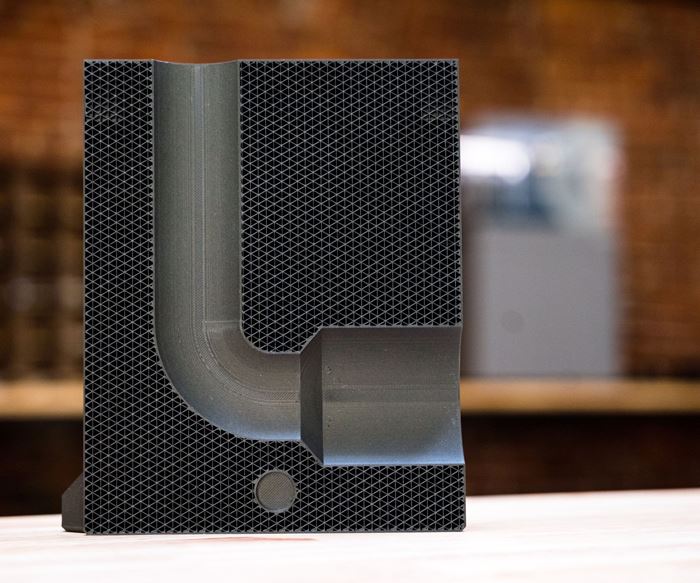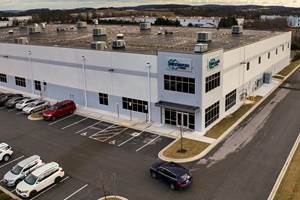Markforged raises $82 million to expand product line
The continuous fiber composite 3D printing pioneer will use capital to accelerate mass production printers, global expansion and new materials, such as FR aerocomposites.
Markforged, a leading manufacturer of industrial 3D printers, has announced that it has closed an $82 million Series D round of funding led by Summit Partners with participation from existing strategic and financial partners, including Matrix Partners; M12, Microsoft’s Venture Fund; Next47; and Porsche SE. Markforged will use the additional capital to help accelerate its product roadmap, including the introduction of mass production printers and new materials.
The capital will also be used to enhance the company’s global expansion plans, strengthen its massive foothold among global manufacturers, and ultimately help to reshape the $12 trillion manufacturing industry.
One example of the company’s vision is disruption in how aerospace interiors and other structures are fabricated. "We are launching flame-retardant composites for use in aerospace applications,” says Markforged CEO and co-founder Greg Mark. “We will soon have a version of Onyx that is V0 rated (UL94) and works great with carbon fiber. A few major players have done some internal flame and load testing with it and we've gotten great feedback. More soon on this, but we're absolutely excited to invest in composites.”
“Markforged set out to change the pace of human innovation by enabling engineers, inventors and manufacturers to print industrial-grade parts at a fraction of the time and cost of traditional methods,” says Mark. “We’re very excited to have Summit join us as we help accelerate the next industrial revolution with broadly accessible and reliable 3D printing.”
The global manufacturing industry sits on the cusp of its fourth industrial revolution. Additive manufacturing — a process that combines 3D printers, cloud-based software and newly-available materials — is set to play a meaningful role in powering this revolution, driving measurable cost reductions and reshaping traditional manufacturing processes into a more efficient digital production line.
By enabling the printing of high-strength parts at an affordable price, the founding of Markforged in 2013 helped mark a turning point in additive manufacturing. Before Markforged, businesses were forced to choose between million-dollar 3D printing systems; less expensive printers capable only of producing weak plastic parts; or the massive complexities and costs of traditional processes, often just to produce a single part. For the first time in the history of manufacturing, it is more economical to print numerous metal or carbon fiber parts than to produce those parts through legacy means.
“We have been actively monitoring the additive manufacturing market for the last decade and are excited to partner with the Markforged team,” says Michael Medici, a managing director at Summit Partners and who has joined the company’s Board of Directors. “Markforged has been quietly executing at an incredible pace for the last five years, delivering exceptional products that solve real-world industrial manufacturing needs. Greg and his team are focused on continued product innovation, and we believe the best is yet to come for Markforged and its customers.”
Prior to this round, Deloitte named Markforged the 10th fastest growing technology company in North America, while Forbes named the company to its Next Billion Dollar Startup list. The company has amassed a large installed base among leading manufacturers and other types of businesses that benefit from additive capabilities. Markforged shipped more than 2,500 industrial printers in 2018 alone, making it one of the largest additive manufacturing companies in the industry. Markforged serves customers in more than 50 countries, and has filed for 133 patents with 38 already issued.
Related Content
New Flyer selects Hexagon Purus H2 tanks for fifth consecutive year
Type 4 tanks will continue to be supplied for the mass mobility provider’s Xcelsior Charge FC fuel cell electric transit buses.
Read MoreComposites reinvent transportation
Celebrating National Composites Week, CW shares ways in which composites continue to evolve mass transit.
Read MoreLongtime partner New Flyer selects Hexagon Purus to outfit hydrogen transit bus
Hexagon Purus will continue to supply Type IV hydrogen tanks for the Xcelsior Charge H2 fuel cell electric bus, the tanks of which will be produced out of Hexagon’s new Maryland facility.
Read MoreHexagon Purus opens new U.S. facility to manufacture composite hydrogen tanks
CW attends the opening of Westminster, Maryland, site and shares the company’s history, vision and leading role in H2 storage systems.
Read MoreRead Next
VIDEO: High-volume processing for fiberglass components
Cannon Ergos, a company specializing in high-ton presses and equipment for composites fabrication and plastics processing, displayed automotive and industrial components at CAMX 2024.
Read More“Structured air” TPS safeguards composite structures
Powered by an 85% air/15% pure polyimide aerogel, Blueshift’s novel material system protects structures during transient thermal events from -200°C to beyond 2400°C for rockets, battery boxes and more.
Read MoreDeveloping bonded composite repair for ships, offshore units
Bureau Veritas and industry partners issue guidelines and pave the way for certification via StrengthBond Offshore project.
Read More

















.jpg;maxWidth=300;quality=90)










